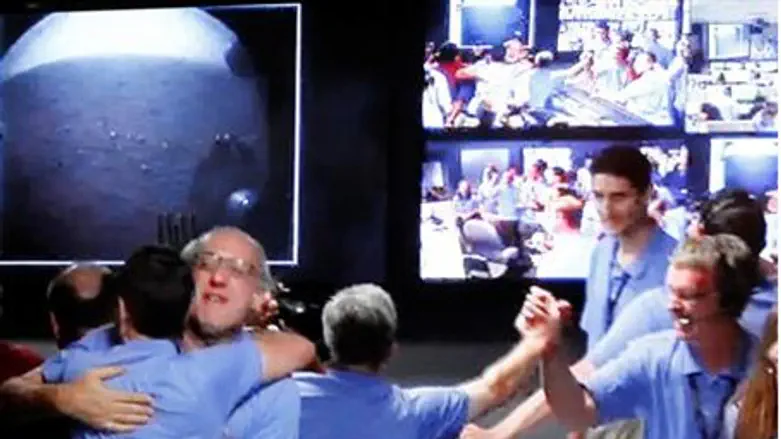
(Reuters) - NASA's Mars science rover Curiosity landed safely early Monday morning Isralei time after hurtling through the pink Martian skies at the start of a two-year quest for signs the Red Planet once hosted key ingredients for life.
Mission controllers burst into applause and cheered in relief as they received signals confirming that the rover had survived its perilous descent and arrived within its target zone at the bottom of a vast, ancient crater.
The robotic lab sailed through space for more than eight months, covering 352 million miles (566 million km), before piercing Mars' atmosphere at 13,000 miles (20,921 km) per hour -- 17 times the speed of sound -- before starting its descent.
Moments after landing, Curiosity beamed back its first three images from the Martian surface, one of them showing a wheel of the vehicle and the rover's shadow cast on the rocky terrain.
"I can't believe this. This is unbelievable," enthused Allen Chen, the deputy lead of the rover's entry, descent and landing team at the Jet Propulsion Laboratory near Los Angeles.
The craft's descent through Mars' thin atmosphere, a feat called the most elaborate and risky achievement in the annals of robotic spaceflight, turned out to be a short-lived cliffhanger, much to NASA's relief.
Curiosity, encased in a protective capsule-like shell, utilized a first-of-its kind automated flight entry system to sharply reduce its speed before landing.
Then it rode a giant supersonic parachute, a jet-powered backpack and a never-before-used "sky crane" to touch down inside a vast impact basin called Gale Crater, located near the planet's equator in its southern hemisphere.
NASA put the official landing time of Curiosity, the first full-fledged mobile science laboratory sent to a distant world, at 10:32 p.m. Pacific time (1:32 a.m. EDT and 8:32 a.m. Israeli time).
Curiosity will spend two years exploring Gale Crater and an unusual three-mile (5 km)-high mountain consisting of what appears to be sediments rising from the crater's floor.
The purpose of the $2.5 billion mission is to look for evidence that Mars - the planet most similar to Earth - may have once harbored the basic building blocks necessary for microbial life to evolve. It represents NASA's first astrobiology mission since the 1970s-era Viking probes.
The exact condition of the rover upon arrival was not immediately clear. NASA plans to put the rover and its laboratory gear through several weeks of engineering checks before starting its two-year surface mission in earnest.
The rover, launched on Nov. 26 from Cape Canaveral, Florida, comes equipped with an array of sophisticated instruments capable of analyzing samples of soil, rocks and atmosphere on the spot and beaming results back to Earth.